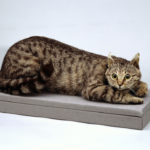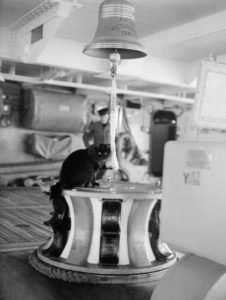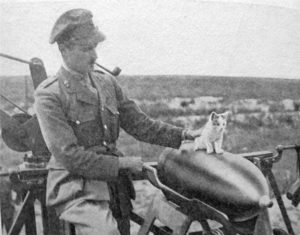A relative came over with a box of meat pastry. It’s a recipe we learned from my grandmother who was born and raised in Indonesia.
When my domestic helper, who happens to be Indonesian, saw it, she kept saying “Risol.”
I wasn’t sure what she was talking about; I had expected her to describe the pastry using the same word as the Malays (being part of the archipelago), which is “Dadar.” And the way she pronounced Risol made it more difficult for me to understand her.
It took a while to realize what she was trying to say.
Rissole!
So I googled the word vis a vis Indonesia – and what do you know? It’s a common word over there.
How on earth did the word Rissole end up becoming part of the Indonesian language?
But of course… their Portuguese and Dutch heritage/history (16th/17th Century).

Some famous wartime cats who performed above and beyond their duty.

Simon
Simon’s efforts for Britain’s Royal Navy didn’t go unnoticed during World War II. He first survived a brutal attack that killed his caretaker, and proceeded to annihilate rats and raise the morale of his crew. He became a national hero, which earned him the prestigious Dickin Medal. He is the only cat ever to receive the award.

Crimean Tom
In 1854, when British and French troops occupied the Russian port town of Sevastopol, Tom led the famished troops to caches of food beneath a rubble hidden along the waterfront by the Russians. Tom was adopted as a mascot by the grateful soldiers. He was later taken back to England when the troops were called back.

Tiddles
Born and raised a ship cat, Tiddles served a few Royal Navy aircraft carriers, including the HMS Victorious in the early 1940s as the official Captain’s Cat. He traveled over 30,000 miles during his naval service.

Faith
She made her home at Saint Augustine’s Church in London in 1936. On September 6, 1940, the mother of one apparently instinctively moved her recently born kitten from the warm upper floors to the basement. The church was bombed by the Germans a day later. Faith and her kitten, Panda, were rescued from beneath the rubble by Father Henry Ross. The cat was later awarded a special medal for “steadfast courage in the Battle of London.”

Pitouchi
The kitten was born in the Belgian trenches during World War I. After his mother was killed, Lieutenant Lekeux of the 3rd Regiment Artillery, decided to adopt Pitouchi, the only survivor of the litter. The Germans were up to something, throwing dirt near a thicket. Lekeux decided to investigate. With Pitoutchi on his shoulder, he left the trenches. He hid in a nearby shell hole to sketch their activity. He didn’t notice the enemy soldiers approaching. When he finally did, it was too late for him to run.
Lekeux hoped the Germans would not see him. When they came closer, he heard one of them say, “He’s in the hole.” Pitouchi jumped out of the shell hole. Startled, the Nazi soldiers fired twice at the cat, but thankfully missed. The cat managed to jump back into the hole. The Nazi soldiers laughed it off thinking they had mistaken the cat for a man. Lekeux returned safely behind the Belgian lines with his unharmed cat.

I guess this would be considered the boy’s locker room by today’s standard. While researching the Colosseum in Rome, I discovered plenty of things that I took for granted about gladiator fights. And then I realized how we’ve been duped by Hollywood.
Contrary to what the movies always show, not all gladiators were slaves nor did they always fight to the death. It’s too expensive to have a dead gladiator, especially after training and investing in these guys. It made no economic sense to exterminate the guy.
The “thumbs down” probably didn’t mean death even. Interestingly, there were also women gladiators.
These guys were even celebrities and icons.
Now we know…
Read further Things you may not know about gladiators








